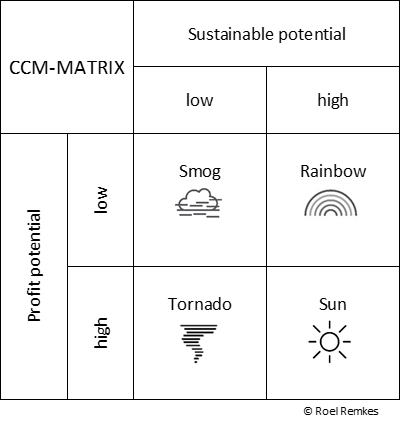 The CCM-matrix is developed in order to make a distinction between companies based on there potential to be sustainable and profitable at the same time. In order to be both sustainable and profitable a company must become a multipurpose company. The multipurpose company is not new concept in itself, however it is undervaluated in the profit driven world that we live in. Now that sustainability becomes more and more important for companies, the concept of the multipurpose company has become interesting again. The multipurpose company is needed for longterm survival...
The CCM-matrix is developed in order to make a distinction between companies based on there potential to be sustainable and profitable at the same time. In order to be both sustainable and profitable a company must become a multipurpose company. The multipurpose company is not new concept in itself, however it is undervaluated in the profit driven world that we live in. Now that sustainability becomes more and more important for companies, the concept of the multipurpose company has become interesting again. The multipurpose company is needed for longterm survival...
Building the multipurpose company for long term survival
There is nothing new about the multipurpose company. It is already known for decades that companies that are interested in other things than just making money, structurally outperform their peers and are able to survive economic crises. In the nineties of the 20th century de Geus (1997) and Collins and Porras (1998) researched and described characteristics of companies that had this special quality. All successful companies they had researched, were aimed at long term survival. To realise that, they had to focus on a whole spectrum of goals. For these companies profit was only the result of their behaviour and a symptom of healthiness. The idea of the multipurpose company fits the wish to create companies that are build for the future. Companies that focus on sustainability and profitability at the same time will stand a chance to survive over the long run. Download a copy of this arcticle.
“It is critical to redefine business purpose beyond inward-facing targets for growth or shareholder returns, and to focus on the contributions that business can make to value chains that work toward the long-term health and prosperity of people and planet.” – WBCSD (2021)
The profitability driven versus the sustainability driven company
The profitability driven company
The most common form of a company is the single purpose, profit driven, company. This type of company is under pressure due to the negative impact it has on the environment, people and the economic system in the long run. This focus on a single objective leads to a race where there is limited room for other responsibilities than making profit.
This type of company can be characterised as: having a single purpose, with a short term orientation, a cost focus, where profit is the only goal, and the main stakeholder is the owner of the company (the shareholder). This is what can be called the ‘Traditional Company’.
The sustainability driven company
The alternative for a single purpose, profit driven company is a multiple purpose, sustainability driven, company. This type of company makes profit and limits or discards the negative impact it has on the environment, people and the economic system. Besides making profit this type of company shows responsibility for their actions and has therefore a multiple purpose, being: profitability and sustainability.
This type of company can be characterised as: having a multiple purpose, with a long term orientation, a focus on contribution, where its goals are profitability and sustainability and the main stakeholder is the society. This is what can be called the ‘Sustainable Company’.

fig 1. Characteristics of the traditional company versus the sustainable company
By adding responsibility to the equation of doing business it is possible to tackle problems such as climate change, pollution and human right violations and support a strong economy for the long run. The current unstable and challenging times offer a tremendous opportunity to change for the better and start building healthy long term focussed companies.
Note: However most companies have only one goal and that is making profit. That doesn’t mean that they don’t show any responsibility or aren’t sustainable at all. It does mean that they aren’t a sustainable company at the moment.
Introducing the CCM-Matrix: four types of companies
The CCM-Matrix
As described above, the sustainable company is has two main goals:
- Making profit; and
- Being sustainable.
The CCM-Matrix is developed to determine and categorise the position of a company based on the focus companies have on the main goals, profitability and sustainability. The CCM-matrix distinguishes four main types of companies (see figure 2):
- Smog – low focus on profitability and low focus on sustainability;
- Tornado – high focus on profitability and low focus on sustainability;
- Rainbow – low focus on profitability and high focus on sustainability;
- Sun – high focus on profitability and high focus on sustainability.

fig 2. CCM-matrix
Smog
The Smog is just there. They are not very effective in making profit and they show limited responsibility. The Smog is suffocating. Because there is no vision, the reason for its existence is unclear. For sustainability this good news. Either the company ceases to exist or the company can move towards a more sustainable company without much resistance.
Tornado
The Tornado is the typical successful traditional company. Very effective in making short term profits while showing limited responsibility towards the environment and people. Therefore the Tornado is destructive by nature. The Tornado depletes natural resources, pollutes the environment, sees people as a resource you can use and supports an economy that has little beneficiaries. Finally this will harm themselves, because every company needs a complete working system (including ecology, society and economy). The Tornado has a good reason and the financial power to move towards a more sustainable company and become a Sun.
Rainbow
The Rainbow is the sustainable company in the making. Not very effective in making profit, showing a lot of responsibility. The Rainbow is especially beautiful for its purpose. Most often it is originated from an idealistic point of view. Being good is more important than earning money. The added value of this type of company is unclear due to its qualitative goals. The question is if the Rainbow can make sufficient profit to sustain itself in the long run. Moving towards a more profitable business model will make this type of company much more valuable and better equipped for their sustainable quest. Becoming more sunny is an option for adding value and long term survival.
Sun
The Sun is the resilient, structural outperforming company for a sustainable future. Effective in making profit, showing lots of responsibility. The Sun is creating value by nature. Companies that aim the be a Sun have incorporated both goals, profitability and sustainability, in their companies ambition, strategy, business model, values and operations. They are a role model for employees, customers, suppliers and other stakeholders. They use the power they have to add value to society and to keep on doing that for a long, long time.
Note: The descriptions of the four categories of companies are made on a distinct version of a company in each category. Of course there are sub-typologies possible.
Conclusions
This article has shown a classification of sustainable companies, based on profitability and sustainability. The model showed that focussing on one or on none goals will not lead to long term survival and value creation. The Smog, the Tornado and the Rainbow type of company will all fail to survive. On top of that, the Tornado will destroy eventually the world around them and itself. The Smog doesn’t harm and doesn’t add value. Its purpose is unclear. The Rainbow looks sustainable, but because it fails to become financial healthy and resilient it is not a sustainable solution. That leaves us with the Sun as only option to be a truly sustainable company. It cares about the environment, the people and the economy. It is balancing profitability and sustainability. For them, profit is the outcome of delivering a contribution to society in the right way.
The outlines of the sustainable company are getting clear. However there is room for further research. The CCM-Matrix is based on prior research on the success of multipurpose companies as done by de Geus en Collins and Porras. The interpretation used in this article is not complete. It is more a starting point for more research on the success of multipurpose companies in the field of sustainability. The work of de Geus and Collins and Porras offer lots of insights to work with.
I want to invite you to join me on this journey in building sustainable companies. Please contact me if you want to join.
Suggestion for further reading
The World Business Counsil for Sustainable Development (WBCSD) has written a report, Time to Transform, in which a clear message and action plan is given by business leaders to businesses around the world. The massage is: "It is now or never" (p1.). The multi-purpose idea which is used in this paper is also at the heart of the plans of the WBCSD. This is a major shift in the mindset of doing business.
The CEO of the WBCSD (Peter Bakker): "I strongly believe that the innovative and distinctive part of this report is the need for leaders everywhere to change their mindsets toward building long-term resilience, toward a regenerative approach to business and ultimately toward reinventing capitalism. Transforming our global systems will take more than just engineers improving the products and services that business produces"
Please take notice of this report: Time to Transform (WBCSD 2021)
A second suggestion for further reading (in Dutch only) is: "Resilient Company Goals". This article elaborates on the types of goals a multi-purpose company could have to become sustainable (resilient). A must read to build the company of the future.
About the author
 Roel Remkes is the founder of Circular Company Makers and interested in sustainable companies since 1998. He aims to help companies to make the transition from a traditional company to a sustainable company. Ever since he went to university, where he studied Business Administration, he has been fascinated by companies that want to combine making profit and being sustainable. Are you interested in this transition?
Roel Remkes is the founder of Circular Company Makers and interested in sustainable companies since 1998. He aims to help companies to make the transition from a traditional company to a sustainable company. Ever since he went to university, where he studied Business Administration, he has been fascinated by companies that want to combine making profit and being sustainable. Are you interested in this transition?
Please contact info@circularcompanymakers.nl.
References
- Collins, J. C., Porras, J. I. (1998), “Built to Last: Successful habits of visionary companies”, London: Random House Business Books
- Geus, A. de (1997), “The Living Company”, London: Nicholas Brealey Publishing
- WBCSD (2021), “Time to Transform – How business can lead the transformations the world needs”

